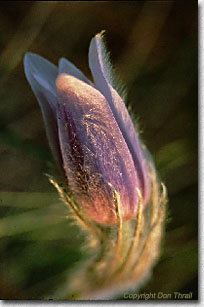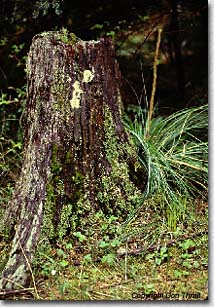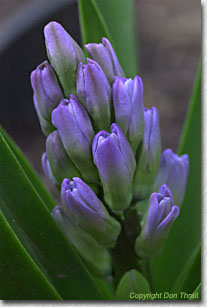|
|
 Feature Article... Up Close and Personal
Text Copyright and Photography Copyright Don Thrall
Close-ups can provide an opportunity to capture good images under less than ideal conditions. Frequently several unique images are possible without moving more than a few feet. Many photographic elements can be controlled when capturing images confined to a small space. An umbrella, a hat, or other handy object, can be positioned between the bright midday sun and the subject to prevent harsh shadows and washed out colors. Electronic fill flash or reflectors can also be used to brighten the shadows, though I prefer the effect of reflected light when it is available. The wind can be deflected with a jacket or other readily available barrier. Cleaning up the background and foreground by moving unwanted elements is appropriate as long as the environment or subject is not harmed. Be aware that in many National parks moving any foliage dead or alive is prohibited.
Another challenge of close-up photography is the requirement for patience. I have to force myself to wait for the wind to die down, or the light to change, to get the image I envision. Even though Iím not known to be a patient man, I am willing to wait, or come back another day, when perhaps the conditions will be right to capture the image. The Mossy Stump was photographed in the Hoh Rain Forest, Olympic Peninsula, Washington. The bright noon sun breaking through the canopy of the rain forest provided spectacular images throughout the forest. However, the 5 to 6 stops of contrast between the light and dark objects made it impossible to expose the scene on slide film without blocking up all the shadows or burning in all the highlights. By looking for areas where the light filtered through the vegetation, I was able to take many photos of isolated subjects. A Nikon F5, Nikon 80-200 f2.8 supported on a Gitzo 340 tripod was used to expose Fuji Sensia 100 to produce this image.
Concentrating on close up images has not only made me more aware of the environment, but it has expanded my overall enjoyment of nature photography. If youíre willing to kneel, bend down, lie in contorted positions, get wet, get dirty and sometimes endure a little discomfort, then you will enjoy getting up close and personal too! |
|
|
 Recently I have been taking more close-up images and have discovered that I get the same sense of excitement when the frame is filled with a colorful flower as I do from a full head shot of a majestic Elk.
Recently I have been taking more close-up images and have discovered that I get the same sense of excitement when the frame is filled with a colorful flower as I do from a full head shot of a majestic Elk. One downside of close up work is the uncomfortable, if not painful, body positions that may be necessary to achieve the desired composition. The Pasque Flower image was taken at sunrise on a chilly spring day. My Nikon F4 with a Sigma 90mm Macro was steadied on a beanbag. A white reflector was used to fill in the shadows with the early morning light. As I had to lie on dew covered ground to get the shot, I ended up wet, grass stained and chilled, but I was very happy with the resulting image.
One downside of close up work is the uncomfortable, if not painful, body positions that may be necessary to achieve the desired composition. The Pasque Flower image was taken at sunrise on a chilly spring day. My Nikon F4 with a Sigma 90mm Macro was steadied on a beanbag. A white reflector was used to fill in the shadows with the early morning light. As I had to lie on dew covered ground to get the shot, I ended up wet, grass stained and chilled, but I was very happy with the resulting image. The photo of the Hyacinth is a digital image taken with a Nikon D1 and Nikon 70-180mm macro lens. One advantage of digital (other than the ability to instantly view your images) is the increase in effective lens focal length. Because of the smaller image size produced by the CCD, the effective focal length of any lens is increased by a factor of 1.5, without changing lens speed or minimum focusing distance. This allows the distinct advantage of being able to get the same composition without crowding the subject.
The photo of the Hyacinth is a digital image taken with a Nikon D1 and Nikon 70-180mm macro lens. One advantage of digital (other than the ability to instantly view your images) is the increase in effective lens focal length. Because of the smaller image size produced by the CCD, the effective focal length of any lens is increased by a factor of 1.5, without changing lens speed or minimum focusing distance. This allows the distinct advantage of being able to get the same composition without crowding the subject.